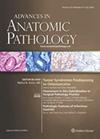泌尿生殖道血管周围细胞瘤(PEComas):综述。
IF 2.6
2区 医学
Q1 PATHOLOGY
引用次数: 0
摘要
泌尿生殖道的血管周围细胞瘤(PEComas)有发生在肾脏的压倒性倾向,在那里它们被称为血管平滑肌脂肪瘤(AMLs)。尽管不常见,PEComas可发生在整个泌尿道(特别是累及膀胱),很少出现在前列腺/精囊和睾丸。在此,我们描述了广泛的临床病理特征的泌尿生殖PEComas肾脏和肾外起源。本文章由计算机程序翻译,如有差异,请以英文原文为准。
Perivascular Cell Tumors (PEComas) of the Genitourinary Tract: A Summary.
Perivascular cell tumors (PEComas) in the genitourinary tract have an overwhelming propensity to occur in the kidney, where they are synonymously referred to as angiomyolipomas (AMLs). Although less common, PEComas may occur throughout the urinary tract (particularly involving the bladder) and may rarely appear in the prostate/seminal vesicle and testis. Herein, we describe the wide clinicopathologic characteristics of genitorurinary PEComas both of renal and extrarenal origin.
求助全文
通过发布文献求助,成功后即可免费获取论文全文。
去求助
来源期刊
CiteScore
10.30
自引率
3.00%
发文量
88
审稿时长
>12 weeks
期刊介绍:
Advances in Anatomic Pathology provides targeted coverage of the key developments in anatomic and surgical pathology. It covers subjects ranging from basic morphology to the most advanced molecular biology techniques. The journal selects and efficiently communicates the most important information from recent world literature and offers invaluable assistance in managing the increasing flow of information in pathology.

 求助内容:
求助内容: 应助结果提醒方式:
应助结果提醒方式:


